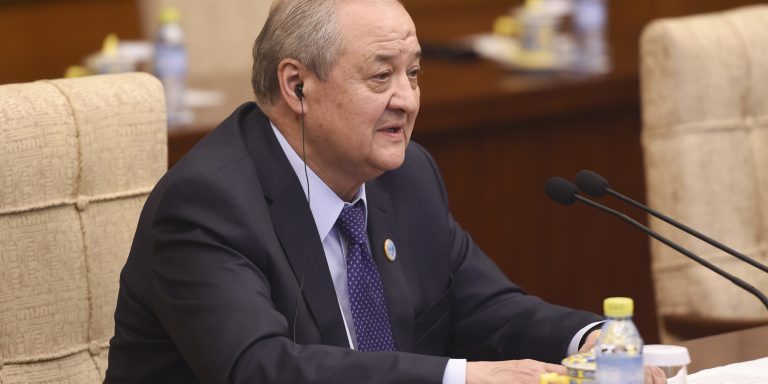INTELBRIEF
December 11, 2018
IntelBrief: Uzbekistan’s Shifting Foreign Policy

- Uzbekistan’s renewed domestic and foreign policies have largely been welcomed by the international community.
- The geopolitical landscape of Central Asia presents a challenge to Tashkent’s ambitions of increased cooperation among the states in the region.
- Russia seeks to re-integrate the states of the former Soviet Union (FSU) into its sphere of influence, whilst the region is also key to China’s ambitious Belt and Road Initiative.
- The U.S. presents a third viable partner for Uzbekistan, but such a partnership must be approached carefully and observe continuous implementation of Tashkent’s ’s incremental political reforms.
.
Under the new president Shavkat Mirziyoyev, Uzbekistan’s reforms have been welcomed by the international community, but the geopolitics of Central Asia may challenge the implementation of Tashkent’s renewed foreign policy. Under the almost three-decade long rule of Islam Karimov, Uzbekistan was considered one of the most authoritarian and isolationist states in the world. Notorious for its forced labor laws during the cotton harvesting season, its powerful and oppressive security apparatus, and atrocious human rights record, Uzbekistan was often ranked alongside North Korea in categories such as political freedom and social justice. Tashkent’s foreign policy was marred by regional border disputes that on several occasions resulted in armed conflict. After the death of Karimov in 2017, and with the new president Shavkat Mirziyoyev in power, Uzbekistan has taken several steps toward political reform. This is particularly important because these reforms have taken place at a time when many states in the international community are moving closer to authoritarianism. The geopolitics of Central Asia, however, with Russia and China competing for regional power and influence, presents a challenge to Mirziyoyev’s ambitions for Uzbekistan.
The reforms target both domestic and foreign policy. Domestically, more than 30 high-profile political prisoners have been released; Karimov’s infamous internal security chief, Rustam Inoyatov, has been removed from office; and a legal reform that allows for judicial transparency and accountability has been implemented. In addition, the government has committed to crack down on forced labor. Tashkent’s foreign policy focuses on regional cooperation, with recent steps in solving some of its long-standing border disputes with neighbors Tajikistan and Kyrgyzstan; Mirziyoyev’s active personal engagement with other leaders in Central Asia; and hosting the Afghan Peace Process Conference earlier this year. Mirziyouev states: ‘effective cooperation of the countries of Central Asia could increase the regional gross domestic product (GDP) by at least two times in the next ten years.’ To insert much-needed capital in the recently liberalized economy, Mirziyouev has also looked beyond Central Asia, signing several deals with other states, including France, Egypt, India, China and Russia. Though the latter two may help Mirziyouev reach his ‘GDP x2’ goal, the two dominating powers’ sway for influence in Central Asia may complicate Tashkent’s desire for regional cooperation.
Putin was quick to establish a personal relationship with Mirziyouev, and in October 2018, at the first Uzbek-Russia interregional forum, bilateral trade and investment deals worth approximately $27 billion were signed. Historically, Russia views Central Asia as its traditional sphere of influence and sees the region as key in re-integrating the ex-Soviet states. Putin might grow concerned if the Central Asian states become too closely integrated, as they would present a more unified front toward Moscow’s policies. Consequently, he is more likely to keep pushing bilateral relations. For China, Central Asia is also key to Beijing realizing its most ambitious foreign policy objective, and perhaps the most important geopolitical strategy of the 21 Century, the Belt and Road Initiative (BRI). Uzbekistan, specifically, will serve as an infrastructure hub for connecting China with Europe mainly through railways. During Mirziyouev’s May 2018 visit to China, bilateral deals worth $20 billion were signed between China’s President Xi Jinping and the Uzbek President. In an effort to diffuse tensions, Beijing continues to stress that BRI is an economic policy, not a geopolitical strategy, although many countries are skeptical of that explanation. Still, with increased Chinese influence in the sphere of security, as signaled by agreements made during the most recent Shanghai Cooperation Organization Summit in Qingdao, Beijing may soon be infringing on what Russia’s believes to be its domain.
For the United States, Uzbekistan’s reforms are viewed positively but pose questions on renewed engagement with Tashkent. In the beginning of the U.S. invasion of Afghanistan, Uzbekistan was a vital partner in the Global War on Terror. After the 2005 crisis, when hundreds of political protesters in Andijan were killed by Karimov’s security forces, the U.S. military base in the country was shuttered. Renewed economic and political support from Washington—28% of foreign investment in Uzbekistan during the first four months of 2018 came from the United States—can provide Uzbekistan a third and more viable option in the geopolitical power-struggle. A partnership with Washington could help Uzbekistan, and its neighbors, to create a rules-based, more independent economic zone, perhaps modeled on the Organization for Security and Co-operation in Europe (OSCE). But for an American-Uzbek partnership to be sustainable, Mirziyouev must follow through on his current reform promises, while also opening up for free elections and political pluralism. For now, however, it is more likely that Putin will opt for an implicit regional partnership with China, as a marriage of convenience, rather than having increased Western influence so close to Russia’s borders. Although Uzbekistan desires stronger regional ties, the geopolitical reality of Central Asia may not oblige—Tashkent is being gradually squeezed between the power triangle of U.S.-Sino-Russia relations.
.
For tailored research and analysis, please contact: info@thesoufancenter.org
[video width="960" height="540" mp4="https://thesoufancenter.org/wp-content/uploads/2018/12/IB-1211.mp4" poster="https://thesoufancenter.org/wp-content/uploads/2018/12/AP_18114314906649.jpg"][/video]